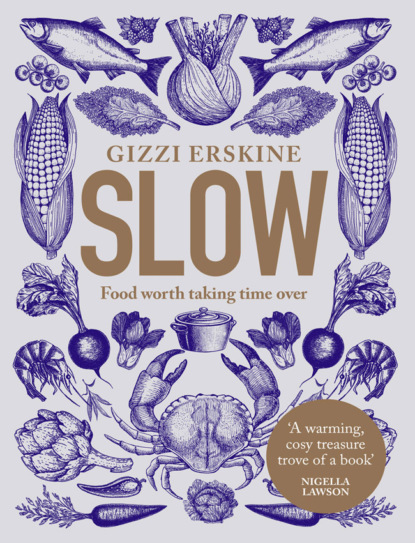По всем вопросам обращайтесь на: info@litportal.ru
(©) 2003-2024.
✖
Slow: Food Worth Taking Time Over
Настройки чтения
Размер шрифта
Высота строк
Поля
SERVES 2 (MAKES ENOUGH SOUP FOR 4)
Preparation time 30 minutes
Cooking time 1 hour
2 tbsp coconut, light rapeseed or groundnut oil, plus extra for frying
1 onion, finely chopped
6 garlic cloves, roughly chopped
3cm piece of ginger, peeled and roughly chopped
2 tbsp curry powder (English or Malaysian)
1 tsp ground coriander
½ tsp turmeric
1 tbsp soy bean chilli oil (Chinese, Thai or Japanese)
1.2 litres boiling water
200g white miso paste
3 tbsp mirin
1 tbsp nutritional yeast
1 tsp Marmite
2 tbsp dark soy sauce
1 tbsp palm or brown sugar
400ml soy milk
200g shiitake mushrooms, sliced
200g firm tofu, cut into thick slices
100ml teriyaki sauce
2 free-range eggs, boiled for 6 minutes, quickly cooled in iced water and peeled
90g buckwheat noodles per person, cooked until al dente and refreshed in iced water
3 slices roasted butternut squash per person (see here (#litres_trial_promo))
2 heaped spoonfuls kimchi
2 spring onions, thinly sliced
½ tsp Korean chilli powder
1 tsp sesame seeds
In a medium casserole, heat the oil over a medium heat and add the onion. Allow to soften for about 15 minutes to develop their sweet flavour before adding the garlic and ginger. Sweat for a further 3–4 minutes before adding the spices. Next add the soy bean chilli oil and give this a couple of minutes on the heat, before adding the water. Whisk in the miso paste, followed by the mirin, nutritional yeast, Marmite, soy and sugar. Allow the sauce to reduce on a low simmer for 30 minutes and then add the soy milk. Transfer to a food processor and blitz until smooth, then return to the pan.
Meanwhile in a frying pan heat a glug of oil and fry the mushrooms over a high heat for 5 minutes until they start to caramelise, then set aside. Return the pan to the heat, add a little extra oil if necessary, ramp up the heat and fry the tofu for a minute on each side, or until really charred. Put the teriyaki sauce in a bowl, add the tofu and the eggs and coat thoroughly. Set to one side.
When ready to serve, divide the noodles between two ramen bowls and pour a quarter of the soup base into each bowl. Slice the eggs in half and place on top. Slice the tofu into strips and arrange next to the eggs, followed by the butternut squash and kimchi. Finally, sprinkle the spring onions, chilli powder and sesame seeds over the top and serve immediately.
Souped-up Kimchi Jjigae (#ulink_15706855-e1ab-56bf-a4f1-a8fde9a8a315)
A few years ago, I lived in Korea for almost six months while filming a show about Korean food. So believe me when I say Koreans live on kimchi – they have it for breakfast, lunch and dinner. But if you ask any Korean what their favourite dish is, they will all say jjigae. A jjigae is a stew and it’s the heart of Korean home cooking. Most people love Doenjang Jjigae which is made with the famous Korean miso paste, but the real red-blooded Korean loves Kimchi Jjigae with its gochujang spiced base and heaps of shredded kimchi. Classically it is made with pork belly, but the Buddhists (who abstain from groin-rumbling fiery chillies) make it without so it can be made vegan with vegan kimchi. The reason this is souped-up is because, although the Koreans call it a stew, I’ve made it a little more brothy. If you want to add carbs you can cook some Korean sweet potato glass noodles and add them to the base.
SERVES 4
Preparation time 20 minutes
Cooking time 30 minutes
splash of rapeseed oil
100g pork belly, thinly sliced or unsmoked bacon (omit if vegetarian)
2 onions, thinly sliced
1 tbsp gochujang paste if you like it spicy or 1 tbsp doenjang paste if you prefer it milder
2 garlic cloves, grated
2cm piece of ginger, peeled and grated
1–2 tbsp Korean chilli powder
1 litre fresh chicken or vegetable stock
400g kimchi, shredded
300g silken tofu, drained and cut into 12 slices
3 spring onions, finely chopped sesame seeds and toasted sesame oil, to serve
First heat a deep-sided frying pan over a high heat. Add a splash of oil followed by the pork belly or bacon. You want to render some of the fat and crisp it up, so fry it for about 8 minutes, moving it around the pan regularly. Once the pork is looking nice and caramelised, remove it with a slotted spoon and set aside. Add the onions to the pork fat and fry for about 5 minutes until they begin to soften and go translucent. (If you are making a vegetarian version, omit this stage and just fry the onions in a little rapeseed oil.)
Next add the spice paste of your choice. I prefer gochujang as I like a bit of extra kick, but you can get a great complexity of flavour from doenjang paste. Give this a stir and add the garlic, ginger and chilli powder and allow to sweat for a few minutes before adding the pork belly. After a couple more minutes pour in the stock. Bring this to the boil and allow to simmer for about 15 minutes. Finally, add the kimchi and simmer for a further 10 minutes.





